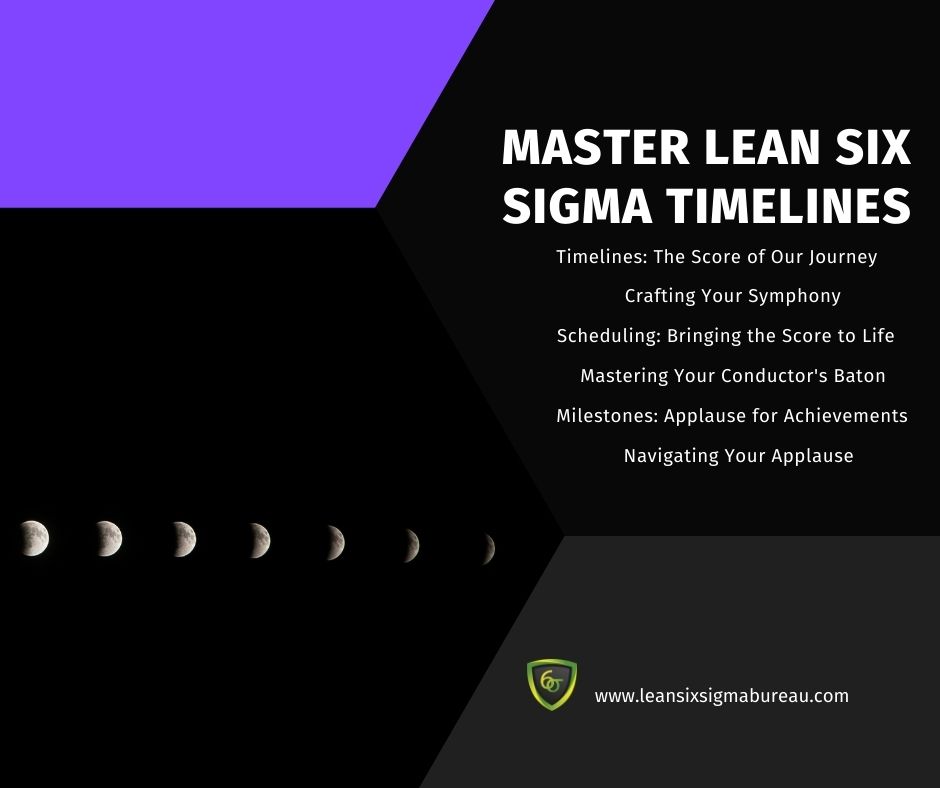The world of Lean Six Sigma thrives on a delicate balance between efficiency and meticulous planning. In this pursuit of excellence, mastering the art of timelines, scheduling, and milestones becomes akin to conducting a symphony – each element plays a crucial role in achieving a harmonious and impactful performance.Timelines: The Score of Our JourneyThink of timelines as the musical score for your Lean Six Sigma project. They provide a clear and structured framework, outlining the project’s journey from inception to completion. Just as a conductor orchestrates the musical flow, effective timelines break down the project into manageable stages, each with its own set of tasks and deadlines. These stages act like movements in the symphony, ensuring smooth transitions and keeping the project on tempo.Crafting Your Symphony:To compose a robust timeline symphony, consider the following steps:
- Define the Overture: Begin by clearly defining your project’s objectives, akin to establishing the musical theme. What problem are you aiming to solve? What improvements do you seek to achieve? Defining your goals sets the tone for the entire project.
- Break Down the Movements: Decompose the project into smaller, manageable tasks. This is similar to dividing the symphony into individual musical sections, making it easier to understand, learn, and execute.
- Assemble the Orchestra: Identify the resources needed for each task, analogous to assembling the various instrumental sections in an orchestra. This ensures everyone has the necessary knowledge and expertise to play their part effectively.
- Set the Tempo: Assign realistic deadlines to each task, akin to setting the tempo for each musical section. Be mindful of the project’s overall timeline and the complexity of individual tasks.
- Resource Allocation: Ensure resources are allocated effectively, taking into account the skills and availability of team members. This is similar to assigning the right instruments and musicians to each section of the orchestra, maximizing their strengths and capabilities.
- Risk Management: Identify potential risks and develop contingency plans to address them, similar to a conductor anticipating potential disruptions and having alternative strategies in place. Build buffer time into your schedule to accommodate unforeseen delays, just as a conductor might allow flexibility in the tempo to account for minor imperfections.
- Constant Monitoring: Monitor progress against the schedule regularly and make adjustments as needed. Stay agile and responsive to changes in the project environment, adapting your approach like a conductor adjusting the tempo or dynamics based on the performance.
- Clear Communication: Clearly communicate milestones to all stakeholders and celebrate achievements together. This aligns everyone with the project goals, fosters team spirit, and keeps the momentum going.
- Performance Evaluation: Use milestones as opportunities to evaluate project performance and identify areas for improvement. This is similar to a conductor analyzing the orchestra’s performance and identifying sections that need further refinement. Learn from both successes and setbacks, continuously refining your approach like a conductor honing the orchestra’s performance throughout the symphony.
- Embrace Adaptability: Be prepared to adjust milestones as needed to accommodate changes in the project scope or timeline. This flexibility is analogous to a conductor adapting the tempo or dynamics based on the overall performance. Maintaining adaptability allows you to navigate the dynamic nature of Lean Six Sigma projects and ensure a successful outcome.


